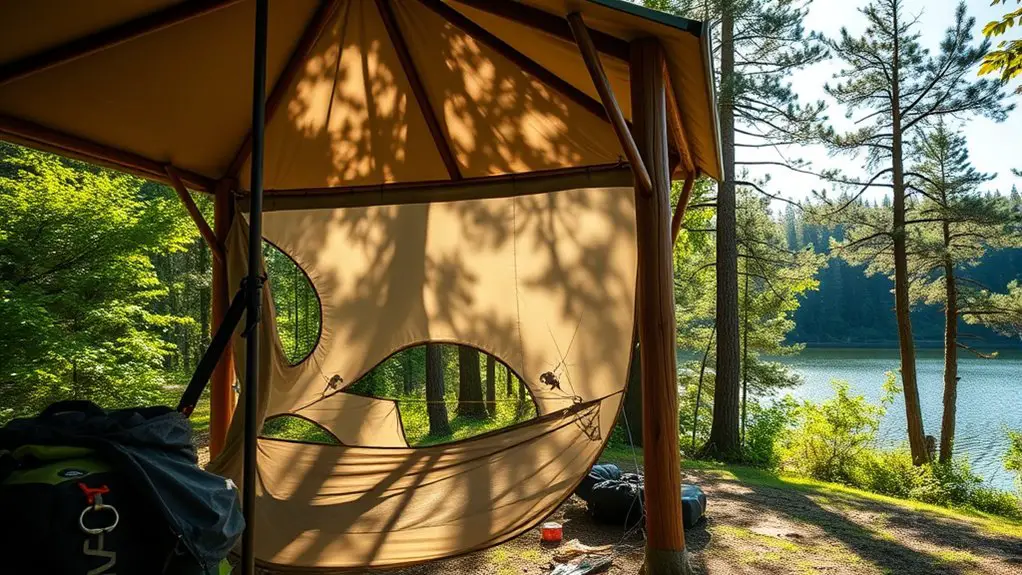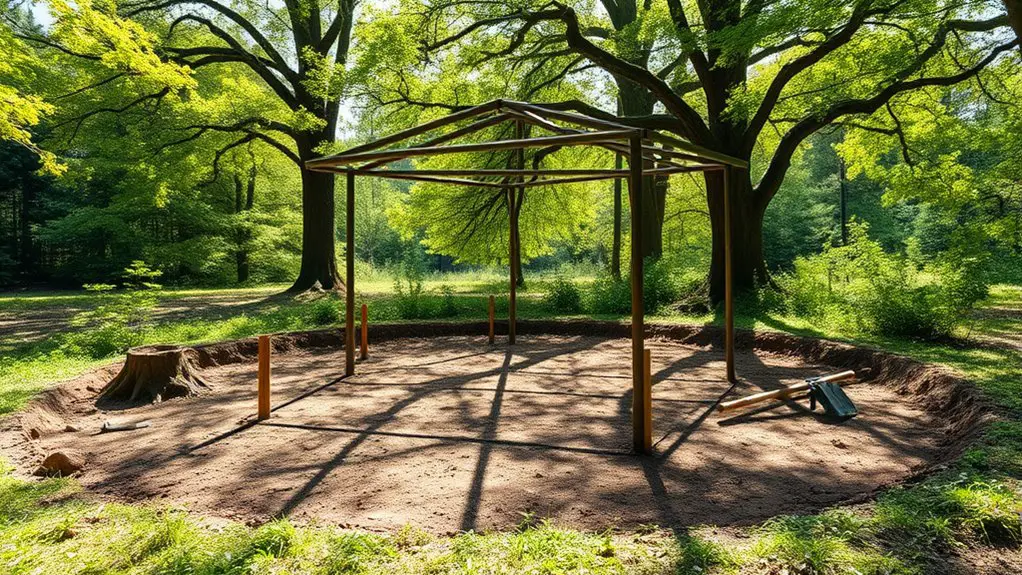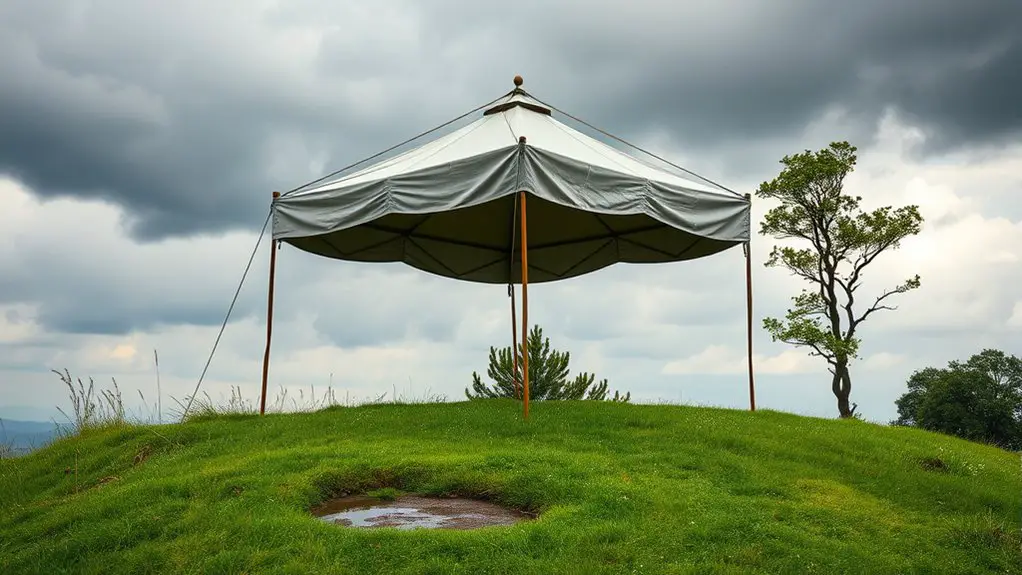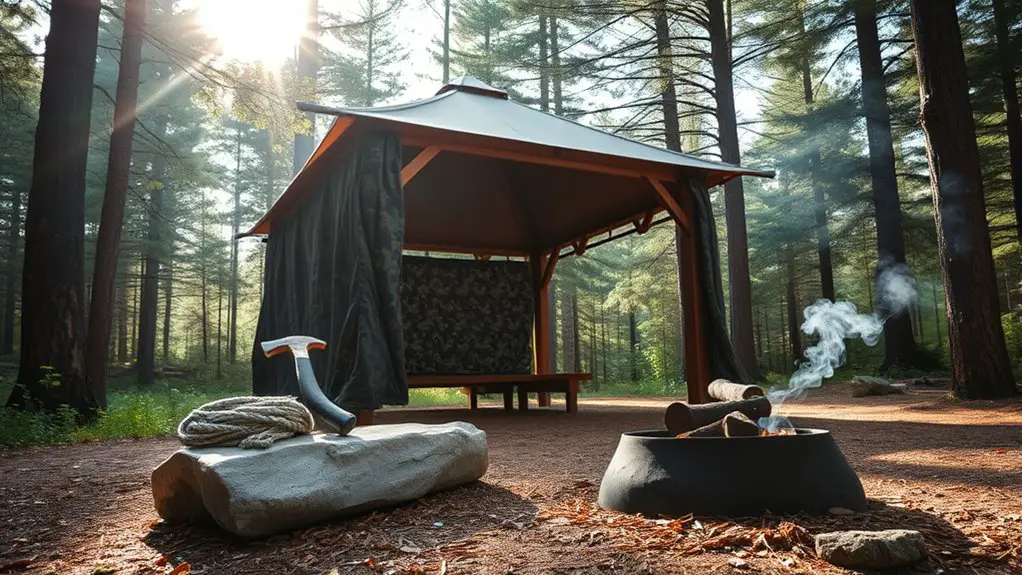To set up a gazebo for an outdoor survival shelter, first choose a durable gazebo made from weather-resistant materials. Find a level, debris-free spot with good sun exposure and minimal wind impact. Clear the ground, then assemble the structure securely, anchoring it for stability. Enhance its strength with additional supports and consider insulation against the elements. Finally, set up a cooking area while prioritizing fire safety. Discover more tips on optimizing your gazebo for practical use.
Selecting the Right Gazebo for Your Needs

When choosing the right gazebo for your needs, what factors should you consider? First, think about material durability. Gazebos made from high-quality materials like aluminum or treated wood can withstand harsh weather, ensuring your shelter lasts. You want something that can handle rain, wind, and sun exposure without falling apart. Additionally, selecting materials that are weather resistant can significantly enhance the gazebo’s longevity.
Next, size considerations are vital. Evaluate the space you have and how many people you want to accommodate. A larger gazebo offers more room for gatherings, but it may require more effort to set up and secure.
Keep in mind the intended use—do you want a cozy spot for relaxation, or a larger space for entertaining? By focusing on durability and size, you’ll find a gazebo that not only meets your needs but also enhances your outdoor freedom, allowing you to enjoy nature without worry. Choose wisely, and you’ll create a perfect retreat!
Choosing the Ideal Location for Setup
Where should you set up your gazebo to maximize its benefits? First, consider sun exposure. Ideally, position your gazebo to provide shade during the hottest parts of the day, which can help keep you cool and reduce heat stress. A north or east-facing orientation is often best, as it limits direct sunlight in the afternoon.
Next, conduct a terrain assessment. Look for level ground that’s free of rocks and debris to guarantee stability. Avoid low-lying areas that could collect water during rainstorms or areas prone to flooding. Also, consider wind direction; placing your gazebo with the open side facing away from prevailing winds can provide added protection. Additionally, ensure that your gazebo’s location allows for easy accessibility for all in case of emergencies, especially for those with mobility challenges.
Lastly, think about proximity to resources like water and firewood. Choosing the right location not only enhances comfort but also guarantees your survival shelter is practical and effective.
Preparing the Ground and Clearing the Area

Before you start setting up your gazebo, it’s essential to prepare the ground and clear the area to guarantee a stable and safe structure. Proper ground preparation and area clearance are vital for your outdoor survival shelter. Here are three key steps to follow:
Preparing the ground and clearing the area is crucial for a stable and safe gazebo setup.
- Clear Debris: Remove any rocks, branches, or other obstacles that could interfere with the gazebo’s stability. A clean area means fewer surprises later on.
- Level the Ground: Make sure the ground is as flat as possible. Use a shovel to fill in any holes and level out uneven surfaces. This’ll help distribute weight evenly.
- Mark the Perimeter: Outline the area where you’ll place the gazebo. This’ll give you a visual guide for both setup and making sure the structure fits well in the space. Additionally, consider laying a weed barrier over the ground to prevent unwanted vegetation growth.
Assembling the Gazebo Structure
Assemble your gazebo structure by starting with the main frame. Lay out all the components according to your tools checklist, which should include a power drill, screws, and a level. Begin by connecting the corner posts to form a sturdy base. Use the assembly tips provided in your gazebo manual to guarantee each connection is secure.
Next, attach the roof beams, making sure they’re evenly spaced. It’s vital to check for levelness as you go; an unbalanced structure can lead to instability. If you’re working solo, consider using temporary supports to hold pieces in place.
Once the frame is up, take a moment to double-check all connections before moving on. This step sets the foundation for your outdoor shelter, so don’t rush it. With the frame sturdy, you’ll be one step closer to creating a reliable haven in the wild. Additionally, securing the gazebo properly with proper anchoring is crucial to prevent wind-related damage.
Securing the Gazebo Against Wind and Rain

Now that your gazebo frame is securely assembled, it’s important to focus on protecting it from wind and rain. You want your shelter to withstand harsh conditions, so here are three key strategies:
- Use Wind Resistance Techniques: Anchor your gazebo to the ground with stakes or weights. This will prevent it from being blown away during strong gusts.
- Select Rainproof Materials: Choose a waterproof tarp or fabric for the roof. Not only should it block rain, but it should also withstand wind without tearing.
- Create Barriers: Set up windbreaks around the gazebo using natural elements like trees or rocks, or erect additional panels to shield it from strong winds. Additionally, consider using secured anchoring methods to enhance the stability of your gazebo against unpredictable weather conditions.
Adding Insulation and Weather Protection
To guarantee your gazebo remains comfortable year-round, adding insulation and weather protection is essential. Start by choosing effective insulation materials like foam boards or reflective insulation. These options can help maintain a stable temperature inside your gazebo, keeping it cozy during cooler months. Next, consider applying weatherproof coverings. Heavy-duty tarps or specialized gazebo canopies can shield against rain, wind, and snow, ensuring your shelter is resilient in various conditions.
For added protection, you might want to install removable panels or curtains made from weather-resistant fabric. This allows you to adjust ventilation and light while still keeping the elements at bay. Remember, sealing any gaps or cracks will also enhance your shelter’s overall durability. Additionally, it’s crucial to perform regular inspections of your gazebo to catch any wear and tear that could compromise its structure. With these upgrades, your gazebo can become not just a temporary retreat but a reliable haven against nature’s unpredictability. Stay comfortable and prepared, no matter what the weather throws your way.
Setting Up Interior Space for Comfort
How can you transform your gazebo into a cozy oasis? It’s all about creating a space that feels inviting and comfortable. Start with some comfortable seating—think cushions or portable chairs that let you relax after a long day.
Here are three essential items to take into account:
- Soft Pillows: Add a pop of color and extra comfort to your seating.
- Cozy Blankets: Keep warm on cooler nights; they’re essential for lounging.
- Interior Lighting: Use string lights or lanterns to create a warm, inviting glow.
To further enhance your gazebo’s atmosphere, consider incorporating soft lighting to create a warm ambiance. With these items, you’ll enhance the ambiance, making your gazebo a perfect retreat. It’s your space, so let it reflect your style and needs. Enjoy the freedom of outdoor living while staying comfortable and relaxed!
Enhancing Stability With Additional Supports
To guarantee your gazebo stays stable, it’s crucial to incorporate additional supports. Start by using ground anchors to secure the structure, then add diagonal bracing for extra reinforcement. Finally, don’t overlook the importance of reinforcing corner supports to enhance overall stability. Additionally, implementing proper anchoring techniques can significantly improve the gazebo’s ability to withstand strong winds.
Use Ground Anchors
Ground anchors are essential for ensuring your gazebo remains stable, especially in windy conditions. With the right ground anchor types, you can enhance your shelter’s durability and safety. Here’s how to install them effectively:
- Spiral Anchors: These screw into the ground, providing strong resistance against wind.
- Stake Anchors: Simple but effective, they’re driven into the earth and attached to your gazebo.
- Concrete Anchors: For permanent setups, these offer maximum stability by securing your gazebo to concrete slabs.
When performing anchor installation, make sure they’re deeply embedded for ideal support. This will help you enjoy your outdoor space with peace of mind, knowing your gazebo can withstand the elements.
Add Diagonal Bracing
While adding diagonal bracing might seem like an extra step, it greatly enhances your gazebo’s stability. By incorporating diagonal support, you’re reinforcing the framework, which helps distribute weight and resist wind loads. This added bracing directly contributes to your gazebo’s structural integrity, guaranteeing it stands strong even in challenging weather conditions.
To install diagonal bracing, cut pieces of lumber or metal that fit snugly between the vertical posts. Attach them securely using screws or bolts to prevent any movement. You’ll notice a significant difference in how stable your gazebo feels once these supports are in place. Don’t overlook this vital addition; it’s a simple yet effective way to make certain your outdoor shelter remains safe and reliable for all your adventures.
Reinforce Corner Supports
After installing diagonal bracing, it’s time to turn your attention to reinforcing the corner supports. This step’s essential for enhancing your gazebo’s stability, especially in outdoor survival situations. Here are some effective corner bracing techniques you can use:
- Metal brackets: These provide strong connections between the posts and the frame.
- Wooden blocks: Cut and fit these in the corners for added support and durability.
- Cable ties: Use these to secure loose connections, ensuring everything stays tight.
Choose the right support material options based on your environment and available resources. Reinforcing corner supports not only stabilizes your gazebo but also gives you peace of mind as you enjoy your outdoor space. Stay secure and embrace your freedom!
Utilizing the Gazebo for Cooking and Fire Safety
When setting up a cooking area in your gazebo, it’s essential to design the space for both functionality and safety. Make certain to follow fire safety precautions and guarantee proper ventilation to prevent smoke buildup. By planning carefully, you can enjoy outdoor cooking without compromising safety. Additionally, ensure that your cooking setup adheres to fire pit safety regulations to minimize risks associated with heat and flames.
Cooking Area Design
To create a functional cooking area within your gazebo, it’s crucial to prioritize both design and safety. Here are three key elements to take into account:
- Cooking Equipment: Choose portable stoves, grills, or campfires that suit your cooking style. Make certain they’re placed on stable surfaces away from flammable materials.
- Food Storage: Invest in airtight containers or coolers to keep your ingredients fresh and protected from pests. Keep them within reach but stored securely.
- Work Surface: Set up a sturdy table for food prep. Having a dedicated space will streamline your cooking process and keep things organized.
Fire Safety Precautions
Cooking in your gazebo can be a delightful experience, but it also comes with responsibilities, especially regarding fire safety. To guarantee a safe environment, start by placing a fire extinguisher within easy reach of your cooking area. A good rule of thumb is to position it near the entrance for quick access in case of an emergency. Additionally, consider installing a smoke detector to alert you to any potential hazards. This simple precaution can save your life and your shelter. Always have a plan in place for extinguishing any flames and never leave your cooking unattended. By taking these fire safety precautions, you can enjoy the freedom of outdoor cooking while minimizing risks to yourself and your space.
Ventilation Considerations
Ensuring proper ventilation in your gazebo is essential, especially if you’re using it for cooking. Good airflow management not only keeps the space comfortable but also helps with moisture control, preventing mold and odors. Here are three key tips to enhance ventilation in your cooking area:
- Windows and Screens: Install adjustable windows or screens to allow fresh air in while keeping pests out.
- Ventilation Fans: Use battery-operated or solar-powered fans to boost airflow when cooking, especially when using charcoal or gas.
- Open Design: Opt for a gazebo design with an open roof or high ceilings to promote natural airflow and reduce smoke buildup.
Packing Down and Maintaining Your Gazebo
While packing down your gazebo may seem straightforward, taking the proper steps can prolong its lifespan and maintain its appearance. Start by removing any loose items and debris. It’s crucial to follow a cleaning routine before disassembling; wipe down surfaces with a mild soap solution to prevent mold and mildew. Once clean, make certain all components are dry to avoid rust or decay during storage.
Next, carefully take apart the gazebo, following the manufacturer’s instructions. Pay attention to any small parts—store them in labeled bags to avoid losing them. Use maintenance tips like applying a protective spray to metal sections and checking fabric for tears or wear before packing. Additionally, regular cleaning helps prevent mould and staining and maintain the gazebo’s condition. Finally, fold the gazebo neatly and store it in a cool, dry place. With these steps, you’ll make certain your gazebo remains ready for your next outdoor adventure, preserving both its functionality and your freedom to enjoy the great outdoors.
Frequently Asked Questions
What Materials Are Best for a Durable Outdoor Survival Gazebo?
When it comes to crafting a resilient outdoor haven, you’ll want durable materials like treated wood or heavy-duty aluminum. A smart shelter design incorporates waterproof fabrics to guarantee you’re cozy and protected from the elements.
How Do I Transport a Gazebo to a Remote Location?
To transport a gazebo to a remote location, consider methods like a truck or trailer for easy access. If terrain’s tough, disassemble the gazebo and carry pieces in backpacks or use a cart for convenience.
Can I Use a Gazebo in Winter Survival Scenarios?
Think of a gazebo as a sturdy ship in winter’s storm. With proper winter insulation and regular gazebo maintenance, it can provide shelter. Just make certain it’s secure against snow and wind, keeping your survival needs met.
Are There Any Specific Tools Required for Gazebo Assembly?
For gazebo assembly, you’ll need basic tools like a screwdriver and level. Familiarize yourself with assembly techniques and guarantee regular gazebo maintenance to keep it sturdy. Having the right tools makes setup easier and more efficient.
How Do I Choose the Right Size Gazebo for My Group?
To choose the right gazebo size, consider the gazebo dimensions and your group’s capacity. Make certain it accommodates everyone comfortably, allowing space for movement. A good rule’s to allow about 10 square feet per person.

